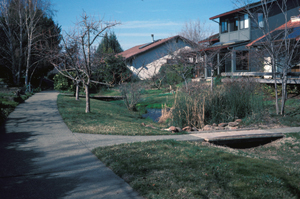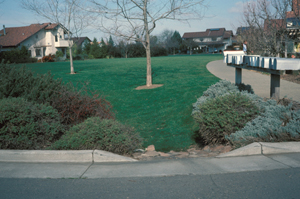Energy Circulation Natural Drainage Open Spaces Agriculture
Natural Drainage
Village Homes’ natural drainage system is a network of small channels that collect rainwater and allow runoff to percolate back into the water table, the City of Davis’ source of drinking water. Light and moderate rainfall drains into common area swales and percolation beds (frequent curb cuts in streets direct runoff into swales). Rainfall from larger storms that does not infiltrate in common area swales runs into a set of larger ponds.
The swales form an integral part of Village Homes’ network of open spaces, which includes pedestrian and bicycle paths, spaces for active and passive recreation, and agricultural land. A rich ecological diversity is supported by the drainage system; there are toads, lady beetles, owls, doves, mockingbirds, kildeer, cedar waxwings, crows, magpies, owls, and flocks of migratory birds. Additionally, small children often play in or near the swales, reveling in their interactions with water, sand, and mud. (Thayer 1993, 290)
Use of the open channel drainage system saved substantial infrastructure costs relative to a traditional subsurface system of catch basins and pipes. Reportedly enough money was saved to fund many landscape features and community amenities in Village Homes.
The drainage system has exceeded the desired goal of infiltrating the entire volume of
the 10-year storm without discharging water to the city’s storm sewer system. When a
50-year storm hit in the mid-1980s, Village Homes infiltrated both its own stormwater and overflow stormwater from the conventional systems in adjacent developments.
(http://www.nrdc.org/water/pollution/storm/chap9.asp#DAV)
 |
 |
 |
| Image Sources: |
| 1. Anne Whiston Spirn 1990 |
| 2. Anne Whiston Spirn 1990 |
| 3. Friedman 2007, 267 |